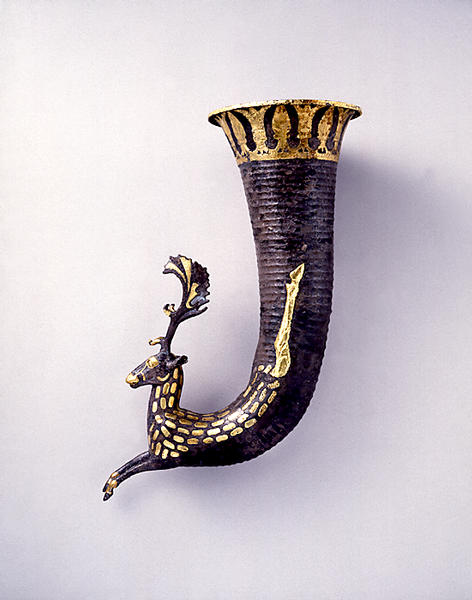Rhyton with a Stag
- Achaemenid period
- 5th - 4th century B.C.
- Gilded silver (Silver, with gold-foil gilding)
- H-31 D-11
Catalogue Entry(Bac#117)
Achaemenid period (6th‐4th century B.C.)
Gilded silver
H. 31.0 cm, Mouth dia. 11.0 cm
The tip of this rhyton is shaped like a stag with extended forelegs. The stag's horns are shaped like spread hands, and the body is decorated with spots, indicating that it is a Dama dama deer. The separately formed cup is decorated with hammered designs depicting the stag's extended hind legs and hindquarters, and the artist used the curving shape of the cup to give a feeling of leaping motion to the animal's form. The forequarters and hindquarters are skillfully joined at the middle of the animal's torso, so that the joint cannot be discerned with the naked eye. The spout is place between the animal's forelegs. The cup section is decorated with horizontal grooves, while the mouth rim area is decorated with guilloches, with a pattern of alternating lotus motifs and palmetto motifs. The major motif areas are plated with gold foil, and this shine heightens the decorative affect of the piece.
The expression of the stag's face, the shape of the vessel, and the decoration on the cup are all characteristic of the Achaemenid period. A similar work in the Metropolitan Schimmel Collection is a silver rhyton with ram decoration with the same hammered out hindquarters and plant motifs on the mouth rim area. However the formation of the animal on the Metropolitan work is somewhat more stylized and heavily formed. By comparison, this work emphasizes the elegant and lively beauty of the Achaemenid period arts seen in their amphoras with ram-shaped handles.
Vessels
The "vessels" division is represented by a relatively large number of objects.There are 22 items of gold (cat. Nos. 123-144) and 26 of silver (cat. Nos. 97-122). Among the silver vessels, there are 6 goblets (cat. Nos. 103-106, 108, 109) tall libation vessels Achaemenid in form, but decorated in a style which is typically Hellenistic. Similar cups are held by the magi represented on the relief sculptures and votive plaques. Three rhyta made for a similar purpose are unfortunately in a fragmentary condition (cat. Nos. 118, 119, 122). In addition there are 8 shallow bowls (cat. Nos. 97-99, 101, 102, 111-113) for ritual libations. The gold vessels were used for the same purpose; there are 18 libation bowls, of simple form, most of which have a rounded base and everted rim (cat. Nos. 123-140). One tall vessel of a pyxis type with a lid (cat. No. 142) appears to be the earliest of the vessels in the collection. Of special interest is an incense burner in the form of a censer with four rings for suspension (cat. No. 141).
Although the number of vessels in this collection is considerably larger than those of the Oxus Treasure in the British Museum, they probably served the same function. The vessels of both collections are closely paralleled by the vessels held by worshippers depicted on the Persepolis reliefs. This observation makes it possible to date them. It is worth adding here that the manufacture of goblets of similar shape and of rhyta in the Persepolitan style is depicted on a relief in a pronaos on the northern wall of the tomb of Petosiris at Hermopolis Magna in Egypt. According to Muscarella, the reliefs attest the manufacture of embossed articles in Egypt right up until 300 BC.
Censer
Shallow Bowl with a Rosette Pattern
Shallow Bowl with a Rosette Pattern
Phiale with a Rosette Pattern
Bowl with a Rosette Pattern
Phiale
Fragment of a Shallow Bowl
Bowl with a Rosette Pattern
Bowl with a Rosette Pattern
Bowl with a Rosette Pattern
Bowl with a Rosette Pattern
Bowl with a Lotus and PalmettePattern
Bowl with a Rosette Pattern
Bowl with a Human Heads Decoration
Bowl with a Rosette Pattern
Shallow Bowl with a Leaf
Plate with Ketos
Bowl
Kotyle with Mythical Figures
Situla with a Lion's Head
Rhyton with a horse protome
Horse (Fragment of a rhyton)
Winged Human-headed Bull(Fragment of a rhyton)
Decoration of a Ladle
Disk-like Round Mirror
Lion Griffin (Fragment of a Rhyton)
Shallow Bowl with a Rosette Pattern
Sallow Bowl
Sallow Bowl
Bowl
Sallow Bowl
Bowl
Bowl
Bowl
Bowl
Bowl
Bowl
Bowl
Bowl
Bowl
Bowl
Bowl
Bowl
Bowl
Bowl with Lid

